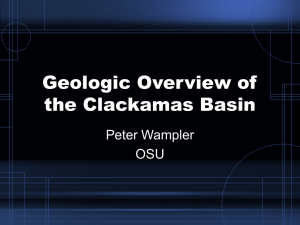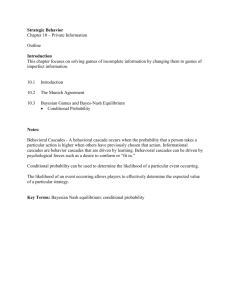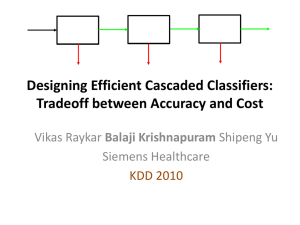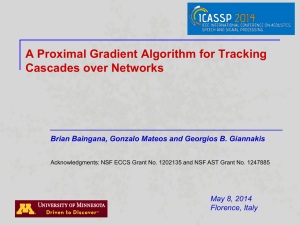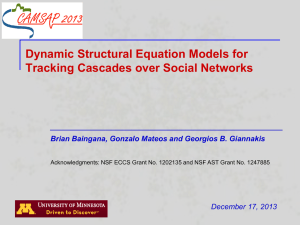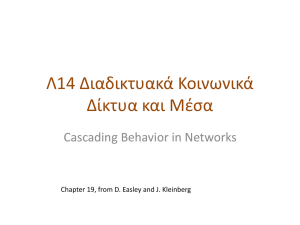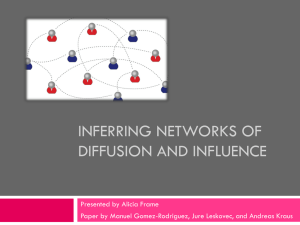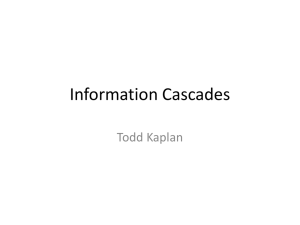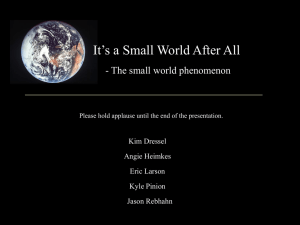The Emerging Science of Networks
advertisement
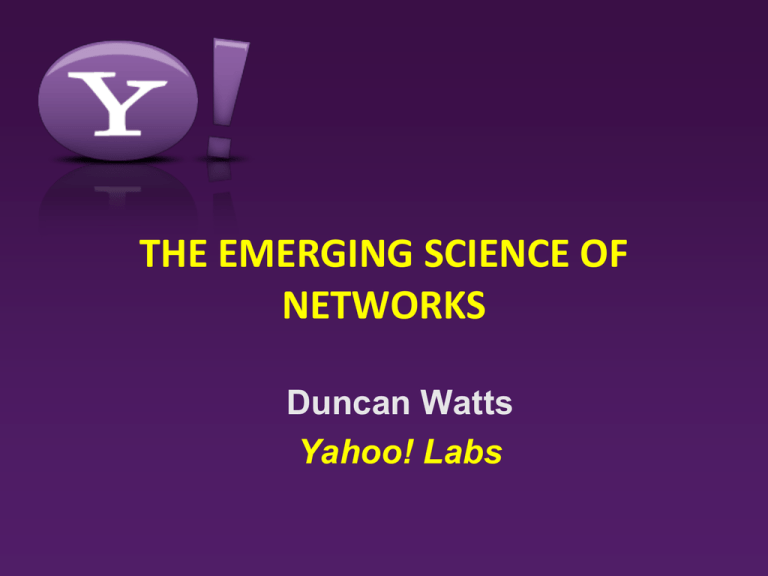
THE EMERGING SCIENCE OF NETWORKS Duncan Watts Yahoo! Labs The Small-World Problem • “Six degrees of separation between us and everyone else on this planet” – John Guare, 1990 – First mentioned in 1920’s by Karinthy – 1950’s Pool and Kochen first math investigation • Milgram’s Small-World Experiment 1960’s • Watts and Strogatz (1998) – showed that “small-world” property was exhibited by many real world networks, including social networks – more generally showed that “complex networks” have interesting mathematical and dynamical properties Network Science • Twelve years later we have a good understanding of how the small world phenomenon works • Also starting to understand other characteristics of large-scale networks • New theories, better models, faster computers, and mountains of digital data all contributing factors • Result has been called “Science of Networks” – 2005 NAS report on Network Science – Thousands of papers, dozens of books, numerous conferences, funding programs, etc. Network Science and The Internet • The Internet is a fascinating social and economic phenomenon in its own right • But it also presents an historically unparalleled opportunity to study social and economic phenomena – Like the telescope for social science • Four examples drawn from past decade that illustrate what is possible Columbia Small-World Project Milgram 1960’s • One target, 300 “letter chains” - 64 reached target WEB EDITION, 2002 • 18 targets around world, 24,163 chains, 61,168 hands, 166 countries • 400 reached targets • 40% to Cornell! • Surprisingly, chains were about the same length • But no “hubs” • Also discovered “bored at work” network • What else could we do with them? Music Lab: A “Macro-Sociological” Experiment CULTURAL MARKETS: • “Hits” are many X more successful than average • Success seems obvious in retrospect, but hard to predict • Can inequality and unpredictability be explained by social influence? • Want to run an experiment • Requires 1,000s of participants • Solution: A “virtual lab” – Expose some people to influence, while others decide independently – Measure effects on individual and collective behavior MUSIC LAB FINDINGS • Individuals are influenced by observations of the choices of others – The stronger the social signal, the more they are influenced • Collective decisions are also influenced – Popular songs are more popular (and unpopular songs are less popular) – However, which particular songs become popular becomes harder to predict • The paradox of social influence: – Individuals have more information on which to base choices – But collective choice (i.e. what becomes popular) reveals less and less about individual preferences • Music Lab not just about Music: – Really about any sort of behavior in which we are influenced by others – Markets construct preferences as well as reveal them INFLUENCE & TWITTER • Music Lab showed importance of influence • But influence in real life diffuses through networks • Twitter is ideally suited to study diffusion – Fully-observable network of “who listens to whom” – Every tweet corresponds to a “cascade” of information – URL shorteners enable us to track each cascade – No matter how small or large • Objective is to predict cascade size as function of – # Followers, # Friends, # Reciprocated Ties – # Tweets, Time of joining – Size of previously triggered cascades Cascades on Twitter • • • • • Two months data Late 2009 1.6M users posted 39M bit.ly URL’s Hence 39M cascades total Average cascade size 1.14 – • Median cascade size 1 Large cascades extremely rare “ORDINARY INFLUENCERS” FINDINGS: • Large cascades are rare, hence: – Probably impossible to predict them or how they will start – Better to trigger many small cascades • Highly visible users tend to be more influential - But only on average – lots of randomness - Also from a marketing perspective, prominent users may also be expensive • “Ordinary Influencers” are promising – May influence less than one other person on average – But may also be relatively cheap – Targeting thousands or millions of unexceptional individuals may be more effective than targeting a few exceptional users Networked Experiments on Amazon’s Mechanical Turk • Created in 2005 Mechanical Turk has developed into a popular “crowd-sourcing” site • Can also be viewed as platform for recruiting and paying participants in behavioral experiments – Networked experiments require synchronous play Collaborative Learning In Networks • Groups of 16 players searching a landscape for “oil” • Payoff determined by hidden “fitness landscape” • Each can see their own performance, along with three of their neighbors, on some network Communication Networks Greatest Average Betweenness Smallest Average Betweenness Smallest Maximum Closeness Greatest Maximum Closeness Greatest Average Clustering Smallest Average Clustering Greatest Maximum Betweenness Greatest Variance in Constraint All Individuals in all networks have 3 neighbors, All Individuals have the same view of the world Short Paths Speed Learning Clustering Reduces Exploration When Do Networks Matter? • At first, seems clear why path length and clustering affect performance – Better efficiency improves learning speed • But previous theoretical work had predicted the opposite result: less efficient networks should perform better on complex problems • And another recent experiment on cooperation found that network structure had no effect on behavior at all • Raises general theoretical question of when networks matter and when they don’t – More experiments will probably be required to guide theory Advantages of the Virtual Lab • Fast, Cheap, and Under Control – Can now run up to 20 sessions in a week with up to 36 players per session – Roughly $1 per player-hour (comp with ~ $10 for physical lab) – Hypothesis-Testing loop shrunk from years to week • Participant pool still not representative, but more diverse than college students • Some subjects have played over 50 games – Longstanding panels open new research opportunities The Future? • In past ten years, we have moved beyond the simple mathematical models of the 1990’s – – – – Small World Exp mapped networks on a global scale Music Lab was a “macro-sociological” experiment Twitter study measured influence in the wild AMT closest we have come to a virtual lab • Still far from the big questions of social science – Systemic risk, wealth inequality, economic development • But every year, new things become possible… Thank You!
